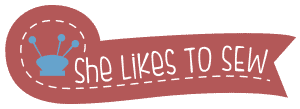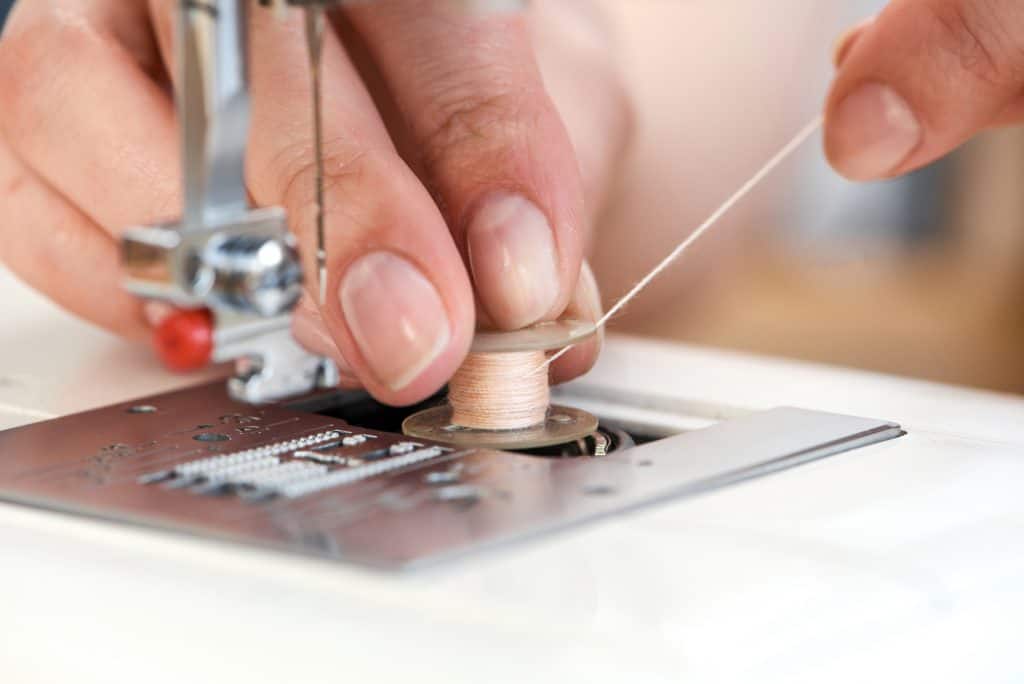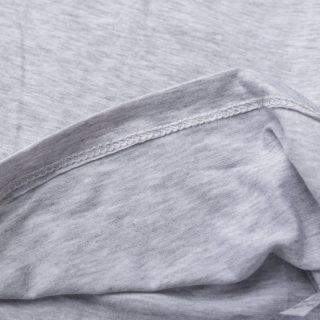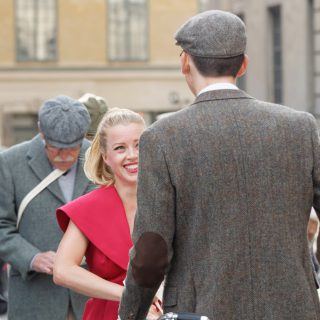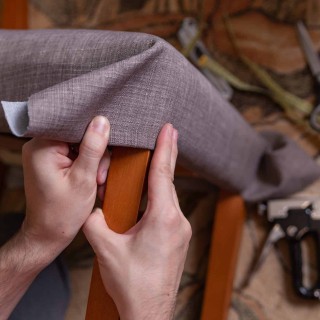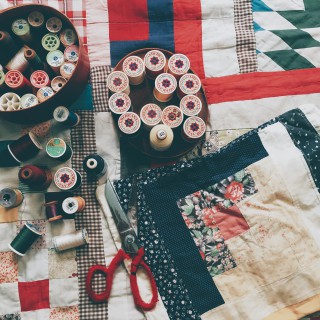If you have already acquainted yourself with all of the sewing terminology and sewing machine parts, then the process of threading a bobbin should not pose a problem for you.
However, if you haven’t and if you end up reading all the guides on how to thread a sewing machine, there inevitably comes a moment from when on you start repeating the word “bobbin” in your mind until it is completely devoid of its linguistic function and is replaced with unidentifiable hums that are actually variations on the Mary Poppins songs accompanied by images of merry bobbins dancing under an umbrella on the dreary streets of London – a fate to dread, indeed.
Your imagination can be prevented from running wild on bobbins just by learning what they are and what they do, though, and Mary Poppins may continue to be a foggy memory as long as you don’t care about greedy Hollywood remakes.
What Is a Bobbin?
I would have liked to provide you with an etymological journey on the word, but there is not much information on that front except for the word being derived from the French bobine, which simply means spool.
And unsurprisingly, a bobbin as we understand it is basically a cylindrical spool mostly made of metal (there are wood and plastic options as well). In most of the sewing machines, it’s sheltered in a compartment right below the needle, and it holds the thread and lets it roll when the machine is running. It is the main element that lets you sew, and without one, a sewing machine would just be an expensive item of décor.
Every brand and model has their own specific bobbins although some might work on others as well, making them not only essential but also unique, and you should keep that in mind when the time comes for replacing the original bobbin featured with your machine. Normally, there will be a couple of extras in the package, but to make sure you never run out of bobbins in case of unforeseen accidents and whatnot, it’s better to purchase at least 5-10 replacement bobbins made for the brand and model of your machine.
What Does a Bobbin Do?
As you should have already observed, there are two threads that are being fed to the needle in a sewing machine. One of these threads comes from above and the other comes from below and together they make a sturdy stitch. The feeding of the lower thread is the responsibility of the bobbin, and that’s why it is situated in a shuttle right under the needle.
To make a bobbin work perfectly, you have to follow the instructions provided in the user manual of your sewing machine for threading and winding the bobbin. The direction the thread should be wrapped around it, how it should be taken out of its shuttle, and how it should be replaced will be clearly explained in user manuals.
If you lost the user manual for your sewing machine or if there wasn’t any, you shouldn’t worry either, because in my guides on how to thread Kenmore, Brother, or Singer sewing machines, I gave thorough instructions on how to take care of that ordeal.
What Are the Other Sewing Machine Parts Connected to the Bobbin?
Needless to say, no matter how unique or essential it may be, a bobbin is not a Western vigilante and it cannot make a sewing machine work all by itself like a lone wolf. For that, it needs to work in line with certain other components of sewing machines such as the bobbin case, bobbin winder, and bobbin tension.
- One of these components is the bobbin shuttle or bobbin case I already mentioned above. The responsibility of the bobbin case is not only to shelter the bobbin from whatever danger may be lurking outside but also to make sure it winds as it should.
- The most important one of these three components is the inbuilt bobbin winder as it takes care of loading the thread. Loading a thread without any obstructions and disruptions is imperative for any sewing project, so if there is any such problem, you’ll make your acquaintance with the bobbin winder as you’ll have to unwind the bobbin and rewind it to correct what went wrong.
- I am not sure if you are ever going to get the chance to interact with the bobbin tension since keeping its default settings will be enough for completing any sewing projects you can undertake. Once you have enough technical knowledge about sewing machines and a practical use for a different bobbin tension, though, you can change those settings however you like. One important note to make about it is, generally those bobbin tensions are set with the material the bobbin is made of in mind. I have said above that a majority of sewing machine bobbins nowadays are made of metal, but there are those made of wood or plastics as well. Just keep in mind that, if you happen to break the original bobbin of your machine and try to replace it with one made of other materials, you’ll run the risk of breaking it due to the bobbin tension. So, don’t do it.
How Do I Wind a Bobbin?
Above, I have already included links for threading different sewing machine models and these guides include the step of winding the bobbin as well, but still, as a kind and considerate blogger, I don’t really want you to go there and try to find the information that suits you. Therefore, below I am going to give you a simple, step-by-step guide you should follow while winding your bobbin no matter what brand or model your sewing machine is and no matter what your bobbin is made of.
- If you are doing a lot of sewing using your sewing machine, then the logical thing to do is having lots of bobbins and using each one for a different color of thread. If you do that, you won’t have to rewind the bobbin whenever you have to change colors. That being said, the first step for winding a bobbin is taking out the old bobbin while the needle is raised to its highest position possible. If there are any thread leftovers on the bobbin you are going to put in, clear them. Let the bobbin be a blank slate.
- The locations of the sewing machine parts differ depending on brand and model, but a majority of them will still follow a certain order: the hand-wheel will be at the right hand side, bobbin winder will be on the top right and next to the spool pin, and the thread guide will be on the top left. The bobbin case, as I said before, will be located right under the needle. Knowing where they are before starting to wind the bobbin is useful when it’s your first time.
- Then, you need to release the clutch if there is any. You’ll see a knob inside the hand-wheel. If you turn it anti-clockwise (again, that’s the protocol for a majority of the models but might change depending on the brand and model of your machine), it’ll release the clutch.
- I have already mentioned how there are two threads fed to the needle when a sewing machine is working and how one of those threads comes from above the machine. The spool of that thread should be placed on the spool pin that should be on the top right of your machine after the placement of the bobbin on the bobbin winder that is right next to the spool pin. Having done that, you have to thread the thread through the thread guide and back to the small hole at the top of the bobbin – if you didn’t place your bobbin on the winder with its holed side up, now is the time to correct that mistake. Then, you should wind the thread just a little bit around the bobbin and click the winder in place.
- Our last step is starting the machine slowly to wind the bobbin. You can increase the winding speed as you go along while also watching the thread. If your machine doesn’t have the feature to stop once the bobbin is completely wound, you need to stop it manually. When it’s completely wound, don’t forget cutting the thread and turning the knob within the hand-wheel to re-engage the clutch.
Now that you have achieved the seemingly impossible task of winding the bobbin perfectly, you can take it out from the winder and place it in its shuttle.
Final Words
In the post that hosts my recommendations for the best sewing books for beginners, I made a couple of implications that the best books and best teachers are those who are capable of demystifying an otherwise technical jargon by providing the beginners with semantic clarity. That’s why I can understand how the air could get really foggy when it comes to the technical knowledge of sewing machines with phonetically weird terms like “bobbin” if you are new to the sewing world.
I hope that this post has cleared a couple of questions for you and that you are capable of uttering the following sentence in a pretty self-confident manner: “Mary Poppins is actually a bad movie, isn’t it?”
